Hard Science, High Hopes: Dealmakers' Roundtable
Masters of the deal converge in New York to discuss the status of their trade and the forces propelling M&A, licensing, and partnerships in the life sciences for 2015.
The momentum behind dealmaking in pharma and biotech is so undeniable that a popular query has been to try to get someone to take the dark side, contrarian position, to hint at a disturbance in a growing bubble. Financing, M&A, and partnering activity appears indefatigable in 2015 with early data outstripping the record-breaking marks from 2014.
This spring, Pharm Exec and Campbell Alliance convened an intimate group of business development professionals, Jedi’s of the life science deal, to discuss current sentiments in the industry. The group gathered at
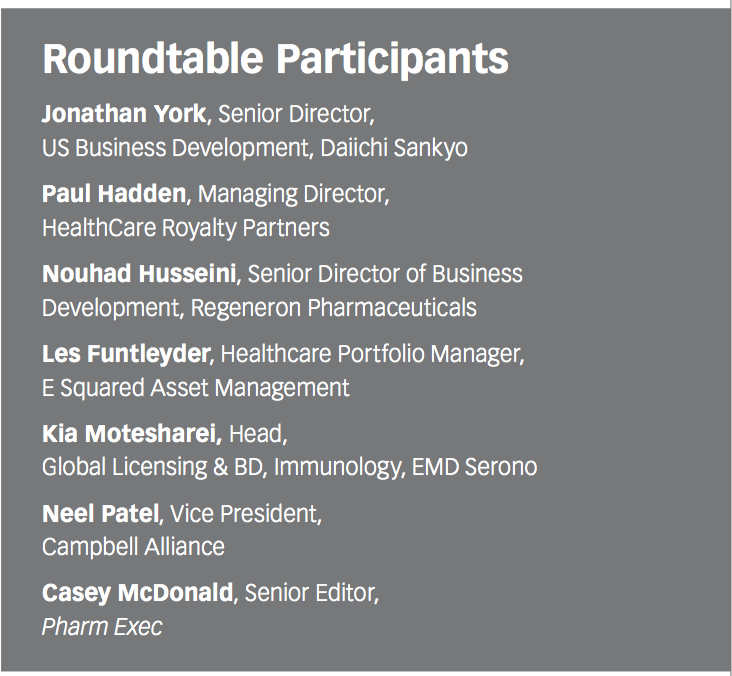
New York’s contemporary beacon for research and collaboration in the field, the Alexandria Center for Life Science.
Per tradition, the group received a sneak peak of Campbell Alliance’s annual survey, Dealmakers’ Intentions. The discussion informed a more complete take on the survey, its seventh iteration, which will make its rounds at the summer blockbuster conference, BIO.
Among the recurring themes from the dialogue was the tremendous fervor across the industry and an agreement that the optimism surrounding life-saving treatments is no industry mind trick. Industry is seeing the culmination of genome era science and deep understanding of molecular mechanisms. The by-products of the exceptional advances are dollar signs with zeros. Excerpts from an afternoon of discussion follow here.
PE: Besides the big price tags and astronomical valuations, we’re seeing great science. Is the connection from science to finance clear?
Nouhad Husseini, Regeneron Pharmaceuticals: Technology has to some extent caught up with itself, and the investments and scientific breakthroughs from last decade are really starting to bear fruit. Consider next-gen sequencing and human genetic research as an example of this, where we are now seeing real benefits from advances in these fields.
In terms of obtaining human genetic evidence that can validate mechanisms of action and doing the right clinical experiment in the right population, I really think all of that is directly connected to the success that we are seeing. You can also look at the fields of cell therapy or gene therapy, where we are seeing some recent breakthroughs, but only after literally decades of investment in basic research and clinical experimentation. Investors who put billions into the sector in the last boom cycle (1999-2001) largely had an unrealistic investment horizon, and were disappointed by how long it took that investment to pay off. Investments in basic science and technology take time, but we are now seeing those investments mature and bear fruit-we are harvesting it now.
Les Funtleyder, E Squared Asset Management: For example, we invest in a gene therapy company with technology dating back to 2000. But the reality is that what we are seeing now is going to be another 15 years, even though there is a lot of excitement about gene therapy and oncology. It seems like we are in the early innings, and we just maybe don’t want to get too far ahead of ourselves, like we did the last time. People thought miracles would happen. It’s easy to forget how long it takes.
My interest, besides the science, is the business model. It’s not like the old pharma model where you go to the pharmacy every month and get the prescription. So how do we reimburse for that? It’s more of a bioethical question, but it is an interesting one that I am pondering, and I would like to hear ideas on that.
PE: When you are talking about a cure, a single pill, or injection, how do you do that financial model that’s at all useful for striking deals? Is there a precedent or tools to look to?
Funtleyder: I don’t think it’s answerable. Arguably, you can say, well, it’s big up front and you come back for a tune-up every year, and if you are still disease free, we’ll pay you some month. I think that is the current standard of thinking, but I don’t know. I don’t know how we are going to do this yet. I think we are going to feel our way around. Given some really good data out there, we may have these conversations more quickly than we are prepared to have them.
Neel Patel, Campbell Alliance: The different dynamics of the US vs. the European Union start to play increasingly more important roles in that payers in the US hold onto a covered life for about three to four years. Thus, they are incentivized to care for those lives for those three to four years. Whereas in Europe, in a country like France, the focus is potentially over the full life of the individual, and this different perspective will interject a new dynamic.
Husseini: Consider potential examples that might be more extreme than Gilead’s Sovaldi. For example, if you had a one-time shot that can permanently cure a genetic disease, it is not hard to argue that such a lifetime cure would be worth a million dollars of value. But who is going to pay that million dollars?
I’m sure we will continue to experiment with different and creative payment models; some will work and some won’t. It is a good problem to have. These patients are getting cured. Hopefully this will be a common problem for the industry.
Funtleyder: There are a lot of ways to skin a cat, we just don’t know which one is the right model yet. Models may work better for the relatively rare drugs, but when you start to get a bigger population, there’s greater complexity. That’s where Solvaldi ran into trouble, not necessarily the price. If 10 people had hepatitis C virus (HCV), you wouldn’t have had a congressional hearing. So now you have a very expensive drug, for a big population. The result has been payer freak-out.
Paul Hadden, HealthCare Royalty Partner: I think it ultimately it will be dependent on the patient population, the incidence, the prevalence, and companies feeling out how best to price a cure given those underlying disease demographics and discussions with payers.
From science to quality opportunities
Patel: What are you seeing in terms of opportunities? Are you seeing an increase in the number of opportunities, or has it maintained a relative steady state?
Jonathan York, Daiichi Sankyo: Let’s put it this way, at JP Morgan, you see maybe 40 or 50 companies, every year, and it’s still the same. I’d probably consider doing a deal with 10%, and this has been fairly consistent. But I think you have to look harder now, especially for late stage assets. That basket has fewer things in it now.
Kia Motesharei, EMD Serono: One thing I have noticed, the good assets are higher quality assets than they were a few years ago. They are well thought out, and better developed to their given stage. I don’t know the reason but maybe it’s because of the transition that many pharma folks have done to the biotech side. They are more familiar with clinical, regulatory, and commercial issues, and they do it more by the books. This is in contrast to how the old biotech used to do it-the cheapest, fastest way possible.
York: While it doesn’t necessarily trickle down to something that is available for partnering, the best science always wins and the science has gotten a lot better. This year you will see it with PCSK9’s, new drugs for heart failure, and PD-1 inhibitors. The average asset you see isn’t that impressive, but the trend is in the right direction.
Husseini: I agree that good opportunities are not going away. As long as there is continued scientific innovation around things like genetic therapies and human genetics research, there will be no shortage of exciting new targets and therapeutics to go after.
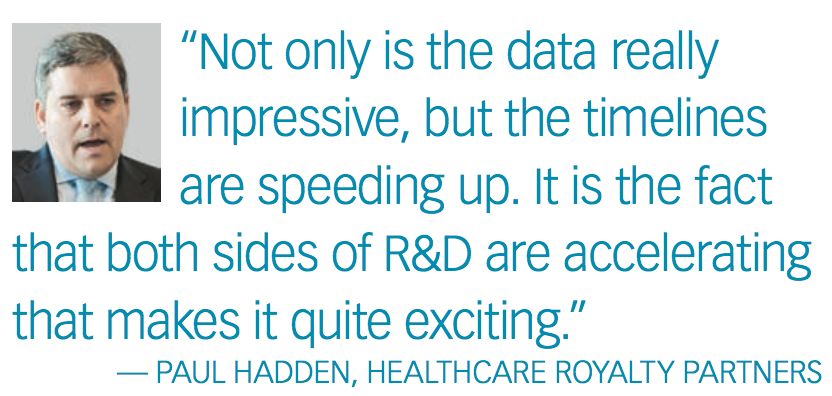
Hadden: The science definitely seems to be accelerating. But it is also the development timelines of those novel molecules. If you look at some of the PD-1’s in oncology, some of them were first humanized in 2008 and then six years later they were launched. So not only is the data really impressive, but the timelines are speeding up. It is the fact that both sides of R&D are accelerating that makes it quite exciting.
Patel:Is it just the good assets that are coming together with a more robust data package or further thought through market research or greater scientific backing? Are all the assets you review now coming with more robust market research and scientific data, making the market more transparent?
Husseini: I try to draw a distinction between the “goodness” of an asset based on its inherent characteristics such as the rationale for its mechanism of action versus how well a given asset has been developed. It sounds like small companies are generally doing a better job developing assets. I won’t argue that. I was reflecting more on the first, just that the science underlying these things is more innovative, more well-validated, putting aside the drug development aspect of it.
Funtleyder: I will add, because we do venture, too, there is still plenty of bad science out there. I can say it, maybe they can’t. We do see stuff and say, “Really, how dumb do we look?” But some still manages to get funded, which encourages people. There is still bad stuff out there.
Husseini: There are bad ideas. Now they are getting funded, whereas a couple years ago they weren’t. So if there is a bubble, that is where it is.
York: The question is what is going to happen in the future. Because there was this period-it’s
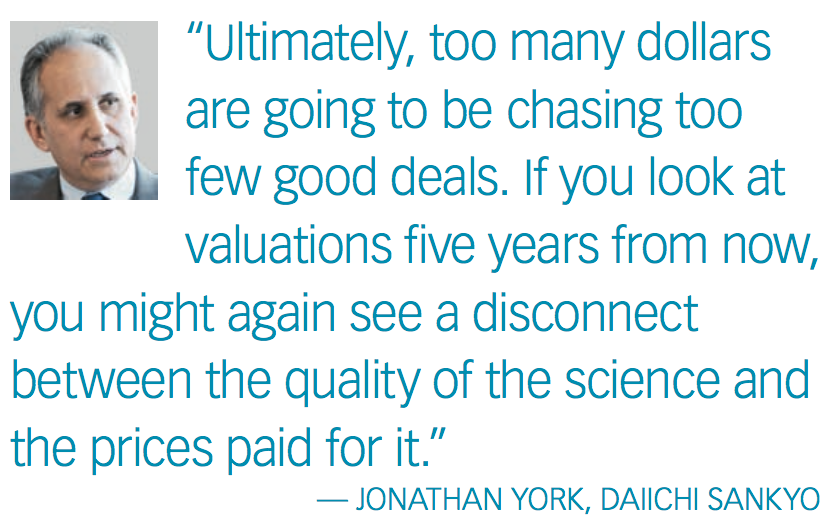
recent where venture funds, a lot of them, went out of business, i.e., they couldn’t raise another fund. But now the IPO window opened and these previously illiquid investments became liquid and people made a great deal of money. Investors who previously said, “I don’t want to allocate that much capital in my portfolio to private equity or venture any more,” those alternative investments now see these big IPOs getting done. That dynamic has resulted in new venture funds getting raised again. Ultimately, too many dollars are going to be chasing too few good deals. So if you look at valuations five years from now you might again see a disconnect between the quality of the science and the prices paid for it.
The bubble question
Patel: All this talk and bluster about whether or not there is a bubble, but if there is an accommodating FDA and, therefore, more products are going to get approved, is that going to temper the bubble or is it not really a bubble in that case?
Funtleyder: That is the trillion-dollar question. All you hear these days is bubble. This would be, I think, the fourth in my career, if this is actually a bubble. Nobody actually says so when it is actually a bubble. The last two, you had two or three lone voices in the wilderness, but everybody was very complacent. I see the opposite now, where people have their finger on the sell button.
Ultimately, in healthcare, not a biotech per se, but we just watched Oscar, an HMO here in New York, go out for a $1.5 billion valuation, and they have 40,000 members. To me that is a bubble. It is probably 10 times what a publicly traded HMO would get for that same thing. I haven’t seen the private valuations creep up the same way yet. But there will be a time, I’m sure, because Wall Street, for no other reason, always over does everything. So eventually we will have a bubble and a crash. But as long as people keep shouting bubble on television, it’s not a bubble.
York: I’m interested to hear what the buyers from your point of view have to say. How much is a dollar of sales worth really in terms of a valuation multiple? Because is it six times sales? 10x? 20x? That’s high. The question is whether there will be consolidation that will take care of some of that excess. I agree with you, you only know in retrospect if AbbVie paying $21 billion for Pharmacyclics was rational or far too optimistic.
Funtleyder: As long as you’re the seller.
Motesharei: One difference between now and what we had back in the high valuation of 2000 is that today’s high valuation is associated with companies that have assets. They have products that are closer to being commercial assets. Back in 2000, the high valuation-and in that case it was a bubble-was based on the technology platforms. Companies that had technologies that were years and years away from making it to the commercial stage. So indeed, the environment is different. You have the high valuation but it’s attached to an asset, whereas before it was attached to a technology that was not immediately ready to be fully capitalized on a commercial market. If valuations were to go down, they will go down gradually. The only single event these days that could “burst the bubble” is a drastic change in payers’ policy.
Hadden: I agree-within the biotech sector, you could have several micro-bubbles. So not a broad bubble per se, but discrete sub-segments of the market where every company in that space is getting the benefit of the doubt right now.
York: I would say to the extent the regulatory environment has been a lot more permissive in terms of both the number of approvals and new pathways for breakthrough therapies, the payer environment has been the opposite. You have to expect that sales and margins are going to compress. If you are trading on a multiple of sales, you have to figure going forward something has to change. The payers finally figured it out. Sovaldi was a wake up call for them. I don’t see that changing, especially the government, relative to Medicare Part D. It is a huge sales driver for many pharmaceutical products. If the government wants to restrict preferred formulary access to a limited number of products, they certainly can. I think going forward, if you are going to tell me sales are coming down and margins are coming down, then valuations are also coming down. The question is, when?
Funtleyder: United Healthcare just bought Catamaran, speaking of deals. It’s not a duopoly, it’s a triopoly, when you have three major payers now, plus the government. The government is still not
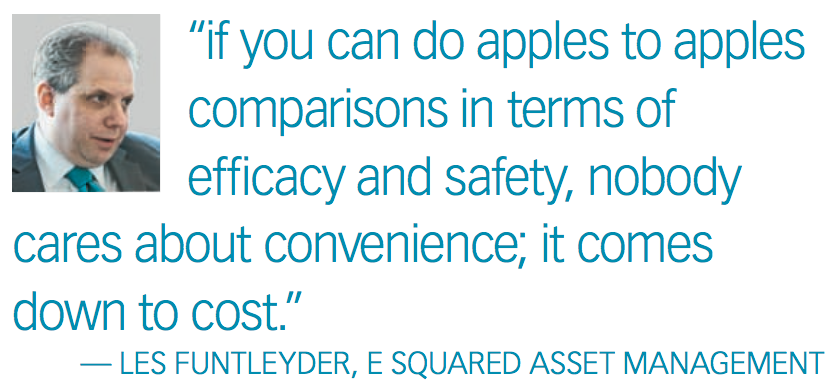
spoken for, by the way. I guess it will depend on who is in charge in 2016. You now have three payers, all of whom saw what they could do when they pushed Sovaldi, for example. But also-and we invest in payers also-they are all saying we are going to ramp up our exclusion list. We are not talking about fifth tier on the formulary. They are saying “no, we’re not paying for it no matter what.” It will be interesting to see how that plays out. I think it will require pharma companies to show pharmacoeconomic value, like differentiation. One thing that Sovaldi and the AbbVie drug (Viekira Pak) taught us is that if you can do apples to apples comparisons in terms of efficacy and safety, nobody cares about convenience; it comes down to cost.
Hadden: Our firm spends a lot of time talking to payers. Our investments are so long term in nature, we have to understand how payers view a space today but also several years downstream. The payer environment has changed dramatically over the past few years-just look at Express Scripts and its exclusion list of more than 50 branded drugs at the start of 2014. The greatest strength payers have is at the start of a drug’s reimbursement life. Going forward, I think you are going to see that payers focus on assets in high value therapeutic areas where there is either a lack of differentiation or no clear clinical benefit between two drugs. In those cases, you will see two sponsors pitted against each other as you did in the HCV market this past year.
Husseini: When it comes to payers and pricing, it will be particularly interesting to watch the PD-1/PD-L1 race. This is unprecedented. There are over a dozen programs in this race-where else have we seen anything even close to this much competition on a single target? I think it’s going to be fascinating to see how the payers influence that when they do.
York: It is worse than that. There was excitement about Opdivo therapy added to Yervoy for the treatment of melanoma. But the question remains, who is paying for combinations of immunotherapies? Are you going to spend $200,000 for these therapies? Nobody’s figured out how to do that.
Hadden: It is going to be fascinating to watch how this evolves, because you are going to have downstream novel oncology therapies that will be added on top of the PD-1/PD-L1 backbone, and how that pricing mechanism gets solved, no one knows. You could have a sponsor going to a payer with three novel drugs, each with three novel mechanisms that could be synergistic and additive…and here’s the six-figure price? That will be an interesting discussion.
Funtleyder: The payer amounts are changing. I don’t know that it’s here yet. It may never come. But some sort of bundling is becoming more common. I’m sure if you did a survey five years ago, there was no bundling. Now there’s bundling. How are these pairs going to deal? If you have a $500,000 treatment for each drug, the PD-1, plus everything else. It’s almost inevitable that there is going to be pricing pressure. Where it comes from might be different. People are going to throw up their hands and say we just can’t afford it.
Hadden: The other interesting trend is that while payers are focused on the immuno-oncology area, trying
to control cost, they will also be trying to take cost out of the system with biosimilars. The biosimilar market will have unique players and price implications that will likely be launching concurrently over the next 5-7 years.
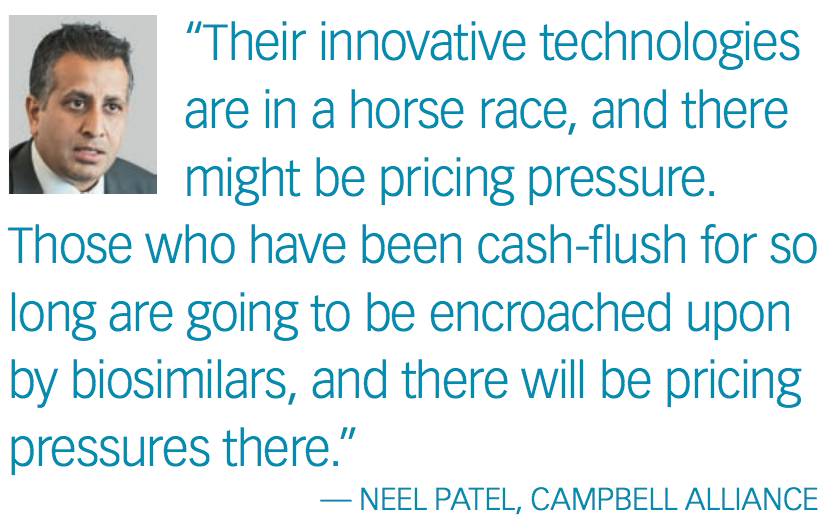
Patel: That brings up an interesting point. Biopharma companies enjoyed their margins for so long they are going to face it in a couple different ways. Their innovative technologies are in a horse race, and there might be pricing pressure. Those who have been cash-flush for so long are going to be encroached upon by biosimilars, and there will be pricing pressures there. It will be interesting to see how deep the margin cuts end up being.
Bringing patients groups to the deal table
PE: Changing gears for a minute, considering the Cystic Fibrosis Foundation example, what will be the role of philanthropy and patient groups getting into the dealmaking space? Will these groups have a more active role?
Husseini: I think so because it gets results. Those groups can connect patients with drugs, with regulators, and move things along. And I think you have seen that these efforts have had success. As they get results, they are going to be playing a role. This is bringing another stakeholder to the table. In terms of the value question, you are not left guessing at the end whether patients and physicians want your drug; engagement with these groups helps you hear up front what the market is telling you they want.
Funtleyder: So full disclosure. I’m on the advisory board of Boundless Impact, which is an impact investment firm. What they are looking for is to get a financial return in addition to a social return. Boundless isn’t the only one. There are a bunch that are trying to connect people with money and interest and people who know how to do such. I don’t know how it plays out, but money, interest, and intelligence, if you can merge those three, you kind of move things forward in a non-traditional path, whereas it used to be strictly a drug company thing.
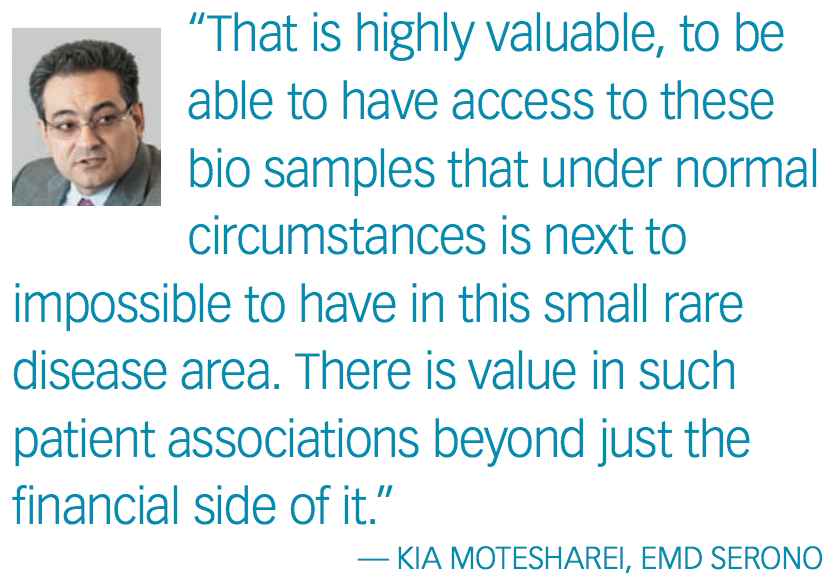
Motesharei: Additionally, the value of these patient associations is they have access to patients and they can convince patients to participate or contribute toward certain studies to help us learn more about their disease. I came across a group that has access to a certain group of patients with a very rare disease. The patients have all agreed to contribute biological samples that can be used for research studies. That is highly valuable, to be able to have access to these bio samples that under normal circumstances is next to impossible to have in this small rare disease area. There is value in such patient associations beyond just the financial side of it.
Hadden: The cystic fibrosis example is a bit unique in the sense that they did something different in terms of investing risk capital in clinical trials-I think they invested close to $75 million. That shows where you can have a real impact in terms of driving different outcomes versus just raising money for awareness and basic research. Look at last summer’s ALS ice bucket challenge that showed the power of some of these organizations to mobilize resources. I think the question is how do these organizations allocate these resources and what actions do they then take to support their underlying mission?
Patel: There is a lot of capital flowing to patient groups. With social media as an enabler, there is greater ability to reach into the community to generate capital. The success story in the Cystic Fibrosis Foundation’s funding of Kalydeco probably is going to be emulated because there is more capital available to patient groups and they will look to generate similar successes within their disease areas of focus.
PE: Is there any risk of complications to having these groups on board?
Husseini: It is challenging when you start talking about the “right to try” concept. You want to help these patients and give the drug, but you also have an ethical obligation to do good science and evaluate if the drug works and actually does something real to help this person.
Funtleyder: We are glad to have them, but we have heard from people that it does close up the comp table a little bit when you have all these groups floating around. We’re happy, but I think we may be the outliers. We don’t care about a messy comp table. So there is not always going to be a great alignment. I don’t see that as a risk.
Mechanics of a deal
PE: Tell us about the process of dealmaking-where some of the snags are and any changes you’ve observed over the years?
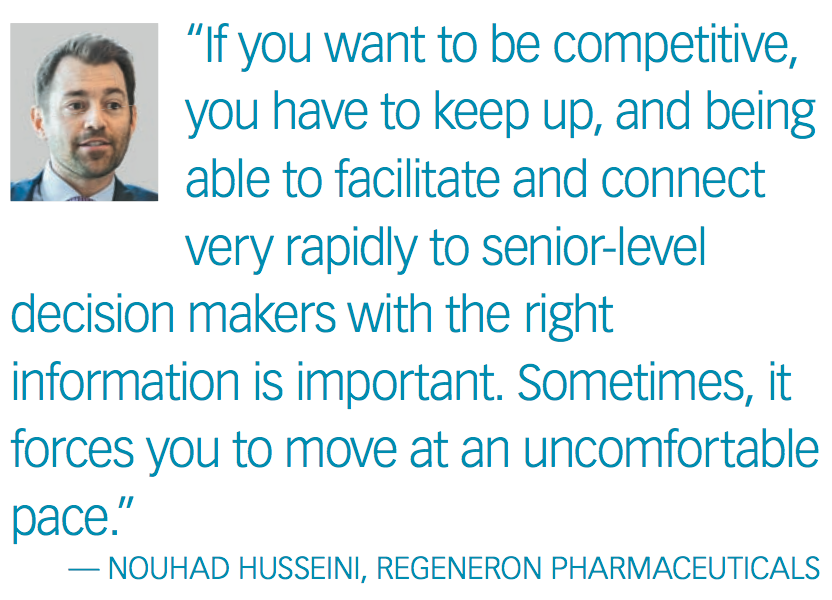
Husseini: Just to connect it to this idea of competition, one of the challenges some companies face is around internal decision-making. Managing internal stakeholders can be a big challenge-trying to get the internal alignment. That can take a lot of time. In a world that has become increasingly fast moving people at the table willing to move quickly-if you want to be competitive, you have to keep up, and being able to facilitate and connect very rapidly to senior-level decision makers with the right information is important. Sometimes, it forces you to move at an uncomfortable pace.
PE: Big companies have the buying power, but can they move quickly enough?
Husseini: Well, you would be surprised. Some of these big companies can do deals fast. Again, it is about getting their really senior people on board. If it is a good strategic fit, if it’s a good deal, you may hear about a company doing a deal in four weeks, start to finish, putting big dollars on the table.
Motesharei: Our deal with Pfizer is an example of that. We partnered our PD-L1 program with Pfizer that from start to finish took six weeks. It set the record for the largest up-front for 50% ownership of a single asset. Pfizer moved very quickly and we kept up with them.
To add to your point about the difficulties to get internal support to move a deal along, there are added complexities, which are based on partners’ demands these days. Many potential partners do not even let you in to look at the data before you submit a non-binding term sheet. I have to go to my senior management, get authorization for a non-binding term sheet, with very little data that the company has provided me, build a case, and try to get an approval for a non-binding term sheet. I am asked “But for what? You haven’t shown me anything.” My reply, “Well, they are not going to show me until I show them what my terms are!”
Potential partners are not making it easier, but they are in the driver’s seat. If you have a good asset you are going to get multiple companies that are going to show interest, and they don’t want to necessarily entertain eight or nine potential suitors. The difficulty for me is to get an approval for a term sheet that goes out, granted it’s not binding. But still, I cannot put a term sheet together until I go through a process, which adds to the complexity of getting an approval internally.
York: We have the same issue. There is a perception by some in the investment community that Japanese companies don’t move as quickly as other pharma players. The reality is that they move just as fast as everybody else. From the inception to the non-binding bid, that part is a lot of work internally. Laying the groundwork for a deal is complex, but by the time we get to the point of issuing a term sheet, we are all aligned. The rest of it goes fast, but doing one in four weeks is really difficult for us. The other thing is a lot of companies are issuing their own term sheets. If you can’t sign up for this, you are not in the process. We see a fair number of things like that also.
Funtleyder:I have a self-serving question. Say I have a Phase II oncology drug with some early data. What is the optimal way to move the process along for Big pharma? Let’s say I call you up, what do you want to see and hear that will get you passed the 10% threshold?
Motesharei: I want to see a compelling story in six or seven slides. I’m the first filter. I get bombarded by opportunities and I don’t have time to go through 50 pages of slides for each opportunity.
York: One of the things sellers usually don’t know going in is what is that potential pharma partner looking for? For example, what is their oncology strategy? It’s really about whether you get through the first filter. Then making the diligence process as user-friendly as possible, having the data site up and running, without too many exclusions on your data site for key information. Everybody wants to do it in stages-I understand that. But really, once you get past the filter, you are at least in the ball game; you want to enable it as much as possible for us. We are looking at a lot of things simultaneously.
Patel: We advise our clients who are looking to outlicense that what they need to do is make it easy for the business development executive to sell the asset to the internal stakeholders. They should try not to run from the question of what the asset is worth. Don’t give the buyer an excuse to say no to a deal because you didn’t address the potential issues with the product head-on, i.e., if you believe there is tremendous pricing power, then you need to have market research to substantiate why you think they are going to get more of a premium. Just try to give the buy-side business development team what they need to go to champion for internal consensus.
Casey McDonald is Pharm Exec's Senior Editor. He can be reached cmcdonald@advanstar.com.

Addressing Disparities in Psoriasis Trials: Takeda's Strategies for Inclusivity in Clinical Research
April 14th 2025LaShell Robinson, Head of Global Feasibility and Trial Equity at Takeda, speaks about the company's strategies to engage patients in underrepresented populations in its phase III psoriasis trials.
Bristol Myers Squibb’s Cobenfy Falls Short in Phase III Trial as Add On Therapy for Schizophrenia
April 23rd 2025In the Phase III ARISE trial, Cobenfy administered as an adjunctive treatment to atypical antipsychotics for patients with inadequately controlled schizophrenia did not achieve statistically significant improvements.
Key Findings of the NIAGARA and HIMALAYA Trials
November 8th 2024In this episode of the Pharmaceutical Executive podcast, Shubh Goel, head of immuno-oncology, gastrointestinal tumors, US oncology business unit, AstraZeneca, discusses the findings of the NIAGARA trial in bladder cancer and the significance of the five-year overall survival data from the HIMALAYA trial, particularly the long-term efficacy of the STRIDE regimen for unresectable liver cancer.
Regeneron, Roche Launch Major US Expansion Plans to Meet Growing Demand for Biologics and Innovation
April 22nd 2025With combined investments exceeding $53 billion, both companies are deepening their US presence through expanded biologics production, gene therapy capabilities, and next generation R&D centers.
Expanding Immune Response Testing to Support Vaccine Development
April 22nd 2025Nigel McCracken, chief operating officer, Virax Biolabs, discusses the expansion of its ViraxImmune platform into areas such as transplant monitoring, vaccine efficacy, latent virus reactivation, and CAR T cell therapy.